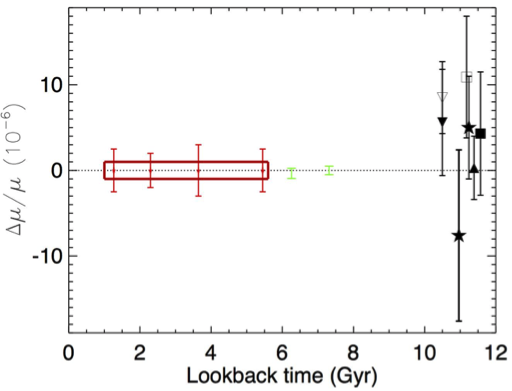Cosmology and Fundamental Physics
Absorption-line systems produced by intervening gas in the spectra of background sources provide sensitive probes of fundamental physics
and cosmology. These probes include (a) the measurement of the primordial abundance of deuterium, linked to cosmological parameters through the Big-Bang nucleosynthesis (BBN);
(b) the redshift evolution of the cosmic microwave background (CMB) temperature (for which any departure from the linear relation could indicate a violation of the equivalence
principle, or that the number of photons is not conserved, e.g. Uzan et al. 2004); and (c) the stability of fundamental constants over time and space. We note that while these
are independent probes, they are intimately related by the underlying physics. For example, models of varying couplings (e.g. Avgoustidis et al. 2014) affect the
temperature-redshift relation, TCMB(z), while BBN calculations of the D/H ratio also depend on the fundamental constants and can be altered if new physics is at play
(e.g. Olive et al. 2012). Observations of electronic absorption lines with optical spectrographs (with R~50,000) on ground-based telescopes have put constraints on fundamental
physics using the above three probes (e.g. Cooke et al. 2018, Noterdaeme et al. 2011, Ubachs et al. 2018). These were obtained for a handful of systems at high redshift,
typically z~2-3, where the lines of interest are shifted redward of the atmospheric cutoff. A few additional constraints have been set at low and intermediate redshifts on
both the variation of fundamental constants and TCMB(z), using radio observations of molecular ro-vibrational lines, but these remain very sparse.
The high spectral resolution UV coverage of POLLUX combined with the large collecting area of LUVOIR will make it a unique instrument for probing new physics through UV absorption lines in redshift ranges not accessible to future ground-based 30m-class telescopes. In particular, the z = [0.5-1] range corresponds to the end of matter domination and the start of acceleration, where, in some extensions of the standard model, we could expect the signatures of new physics, associated with the onset of domination by dark energy (e.g. Mortonson et al. 2009).
ex ≈TCMB , e.g. Noterdaeme et al. 2011). The
measurements are based on the relative column densities in different rotational levels, for which the corresponding lines in a given band are separated by only a few kilometers
per second. The statistical uncertainty is currently of the order of 1K but this is expected to linearly correlate with the achieved S/N ratio and the spectral resolution.
Only POLLUX will allow full separation of the rotational lines and obtain high-precision measurement of the excitation temperature. We estimate that, for S/N~100 and R~120,000,
the statistical uncertainty on Tex becomes less than 0.1 K. In addition to the main CO bands (at 100-150 nm rest-frame), the associated H2 and the main CI fine-structure lines
will be covered by POLLUX at z < 2.4. These are crucial to derive the physical conditions in the gas (e.g. Noterdaeme et al. 2017, Balashev et al. 2017) and correctly estimate
the contribution by collisional excitation.
CMB (z) relation, the precision depends almost linearly on the achieved S/N. For 100h exposure time, the
precision on ∆μ/μ is of a few parts-per-million in each individual case, close to what has been obtained from radio observations of NH3 inversion
transitions in rare systems (Fig.1).
Finally, we note that POLLUX will probe lookback times not covered by any other observation.
The high spectral resolution UV coverage of POLLUX combined with the large collecting area of LUVOIR will make it a unique instrument for probing new physics through UV absorption lines in redshift ranges not accessible to future ground-based 30m-class telescopes. In particular, the z = [0.5-1] range corresponds to the end of matter domination and the start of acceleration, where, in some extensions of the standard model, we could expect the signatures of new physics, associated with the onset of domination by dark energy (e.g. Mortonson et al. 2009).
The D/H ratio
The relative abundances of primordial light elements depend directly on the product of Ωb and h2 and on the physics considered in the BBN calculations. The measurement of D/H in primordial gas therefore places limits on possible departures from the standard physics, in particular through independent constraints on the cosmological parameters. Accurate measurements are possible by observing the Lyman series of DI and HI, which have rest-frame wavelengths in the range [911-1215] Å. POLLUX will enable precise measurements at 0.3 < z < 2.3 thanks to the simultaneous observations of the full Lyman series in its medium-UV and near-UV arms. At z < 0.3, the Lyman series extends over the far-UV and medium-UV arms, meaning that two observations would be required. The FUV alone can cover the full series for the local Universe (z~0). For typical gas temperatures of ~104 K (e.g. Noterdaeme et al. 2012), the DI lines are resolved at R~50,000, but a higher resolution remains mandatory to deblend components and properly assess the unabsorbed continuum regions in between Lyα-forest lines. This is only achievable with POLLUX. The accuracy on D/H depends on factors such as the density of the Lyα forest (see Cooke et al. 2014) but, for a given system, it linearly correlates with the S/N. Cooke et al. reached a precision of about 0.01 dex on D/H at high-redshift using spectra with S/N~40 and R~50,000. Since the Lyα forest is less dense at lower redshift, such an accuracy should easily be reached with POLLUX in a few hours of observing time for 0.3 < z < 2.3 systems towards m~18 quasars. The main difficulty will be to identify low-metallicity systems for the measurement. Low metallicity is indeed important because it mitigates astration effects (destruction in interiors of stars) and provide potentially better constraints for BBN models.Evolution of the cosmic microwave background (CMB) temperature
Several interstellar species have transition energies in the sub-mm range and can be directly excited by photons from the CMB. A few, rare, CO absorption systems at z>1.6 have been used as a direct CMB thermometer in diffuse gas where collisional excitation is small (i.e., TVariation of fundamental constants
Modern theories that try to unify the fundamental interactions predict the variation of fundamental constants over cosmological times and scales (e.g. Coc et al. 2006). Such constants determine the quantum mechanical energy-level structure of atoms and molecules. Comparing spectra of the same species in different places in the Universe and in the laboratory can therefore set strong constraints on any space-time variation of these constants (e.g. Ubachs et al. 2016). In particular, the proton-to-electron mass ratio (μ) can be constrained in the distant universe by observations of the Lyman and Werner bands of molecular hydrogen (~900-1100 Å rest-frame). Similarly, combining the resonance UV metal absorption lines with 21-cm absorption lines, from the same absorber, leads to a stringent constraint on a combination of fundamental constants, say x = gp α2/μ, where α is the fine-structure constant and gp is the proton gyromagnetic factor (e.g. Rahmani et al. 2012). The high resolution of POLLUX will provide better precision on single-component wavelength measurements, but also the de-blending of different kinematic components and the identification of hidden components, which otherwise produce systematic errors. As for D/H and the T


